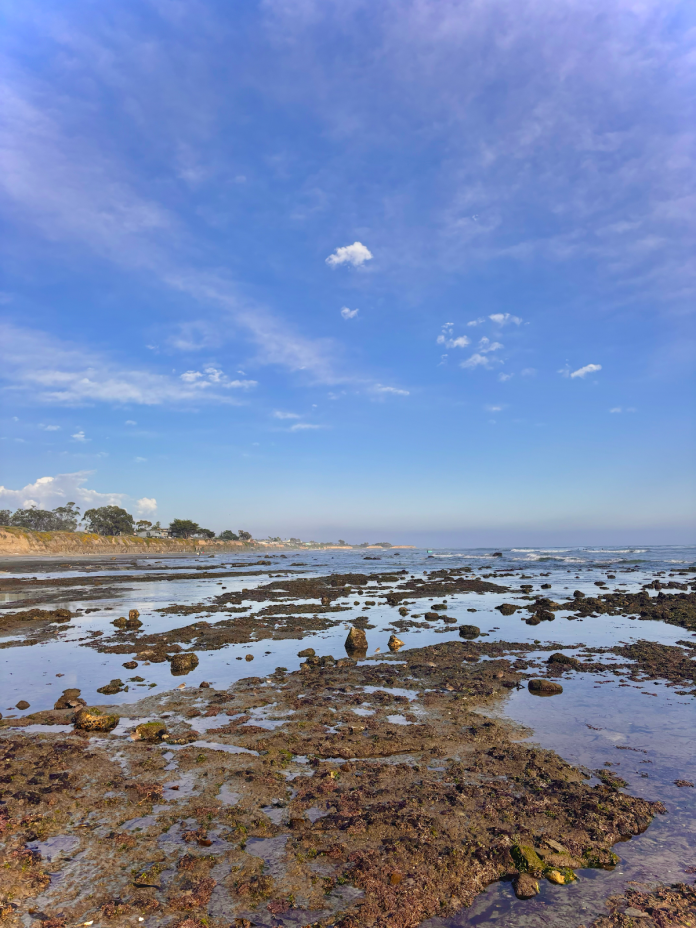Lily Mott
Contributing Writer
Santa Barbara beaches are not just a place with a lovely view — their tidepools reveal a hidden marine world. Low tide exposes these rocky pools to reveal various types of algae, coral, anemones, hermit crabs, and rockweed. These tidepools flourish with life and allow us to see into a window of a unique ecosystem. A closer look reveals a variety of animals and plants that together help preserve the delicate balance of this ecosystem that constantly adapts to shifts in water level, temperature, and salinity.
Among the most interesting of organisms in UC Santa Barbara’s (UCSB) tidepools is the aggregating anemone (Anthopleura elegantissima). At first glance, they resemble soft, underwater flowers, although their tentacles are lined with tiny stingers to capture prey. Sources confirm that they are often bunched together on rocks, creating squishy green mats, but their truly special feature is that they can clone themselves and expand to occupy more territory. This ingenious maneuver allows them to thrive in the continually changing tidepool habitat and act as an important player in this unique shoreline niche.

Staghorn corals (Acropora cervicornis) are commonly found growing on top of the rocks. Colorful coral is another tidepool thrill; the vibrant colors and extensive maze of their growth contribute to the excitement of tidepooling. Though people often do not associate them with tidepools as they do with tropical reefs, some types of coral and coral-like organisms live in intertidal areas, making the habitat more complex. Coral plays a key part in stabilizing rocky surfaces and giving small invertebrates a place to hide. It contains calcium and strengthens tidepool areas against the constant hit of waves, helping the ecosystem’s ability to recover over time. Besides coral’s bright colors, it plays a key role in filling tidepools with various other species, giving them shelter and food.

Hermit crabs (Pagurus spp.) hide in small corners of tidepools. They do not build their shells like other crabs. Instead, they use empty snail shells for safety. When hermit crabs grow larger, they search for bigger shells and often compete with each other for them. Hermit crabs clean up tidepools by eating leftover food scraps, which makes them important as decomposers for the ecosystem. People who visit the beach can watch these small creatures move over rocks and (sometimes) take shells from their neighbors. It’s quite a show if you’re interested in exploring tidepools.

The National Oceanic and Atmospheric Administration states that each high tide brings waves that deliver fresh nutrients and microscopic organisms, like plankton, which sustain and replenish the pool’s delicate food chain. Tidepools contain a vast variety of organisms, serve as nature’s classroom, and provide a chance for research. Many environmental scientists study tidepool organisms to understand how climate change affects marine life. The most common impacts of climate change on tidepools are rising global temperatures, ocean acidification, and anthropogenic disturbances. Since tidepools are fragile habitats, anemones and hermit crabs are currently at risk of losing their homes, while coral slowly dies and is washed back into the ocean.
To human visitors, tidepools provide a chance to connect with nature, but responsible exploration is key. Stepping on fragile organisms, collecting shells, or disturbing wildlife can disrupt these tiny-but-complex ecosystems. A good rule of thumb? Leave no trace. Meaning to minimize human impact on nature, with practices like packing out waste, staying on designated trails, and respecting wildlife to preserve outdoor spaces and ecosystems.
Santa Barbara’s tidepools are a true natural treasure, revealing the incredible adaptability of marine life. By respecting the tidepool habitats and supporting conservation efforts, researchers, students, and beach-lovers alike can ensure that future generations of UC Santa Barbara students can continue to admire all the crawling crabs, swaying anemones, and hardy corals that make these pools so special.
So the next time you are at the beach, stop and peer into a tidepool, and you might be very surprised at what you see just below the ocean’s surface.











